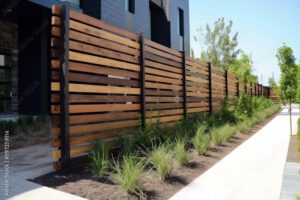Predators pose a significant risk to farm animals, leading to income loss. Having reliable farm fencing can keep predators away from your livestock and crops. Fences mark property boundaries, which helps prevent trespassing on your land by neighbors or developers. They also separate pastures from production areas, which maximizes the use of your crops and animals. Visit https://fencingsummerville.com/ for more information.

Wood farm fences are one of the most common and versatile fencing options. They are a natural, environmentally friendly material that can be used to contain livestock, mark boundaries, and enhance the farm’s landscape. Various wood species provide farmers with options that suit their budget, purposes, and aesthetic preferences.
In addition to being a cost-effective option, wood is a long-lasting material that can be treated for longevity and resistance to weathering. A properly constructed and maintained wooden fence can last up to 30 years, providing long-lasting protection for the investment.
Farmers should choose quality materials for the board and rails to ensure a lasting wood fence. Pine and cedar are most commonly used because of their strength and durability. To further prolong the life of wood boards, they can be painted or stained with preservatives to prevent moisture from damaging the surface.
Another way to extend the life of a wood farm fence is to use pressure-treated lumber. This material is infused with preservatives that help to protect against mold, insects, and other harmful bacteria. It is recommended that the boards are ruff-sawn cut to a thicker dimension To increase the strength of a pressure-treated wood fence.
Split rail wood farm fences are a popular design with a rustic appearance. They are typically made with 2 or 3 rails. The rails are made from full-length logs cut into sections and fit over each other to create the fence’s structure. The rails should be spaced no more than 8′ in the center for maximum strength.
A wood farm fence can be enhanced with wire fabric to add strength and height to contain animals or keep predators out. Three types of wire fencing are available for wood farm fences: barbed wire, woven wire, and welded wire. Barbed wire fences are usually the cheapest to install but are the weakest against predators and strong winds. Welded wire fences have horizontal and vertical strands of metal that are welded together at their intersections. It is available in several gauges and can be galvanized or vinyl coated in black, brown, or green.
Various metals are used in farm fences to mark boundaries, secure livestock and crops, and keep predators out. Metals are often more affordable than other types of fencing and require minimal maintenance. They also provide a high level of security and can be easily customized. These advantages make them popular with farmers.
Metals are malleable, making them easy to shape and curve. They are also durable and less likely to be damaged by animals. In addition, they are more resistant to pests, mildew, and termites than wood or vinyl. Many metal farm fences are galvanized, which protects the material from rusting and corrosion. Other coatings, such as powder coating, are environmentally friendly and offer improved durability.
In addition to the traditional post and rail fence, some farms use chain link fences. These fences have a woven wire core surrounded by a mesh of galvanized steel links, and they are usually used to contain small livestock, such as goats or chickens. They are also commonly used in corrals or pens for horses and other large livestock.
Electric fences are another common type of farm fencing. They are designed to deter livestock from straying too far from the fence by giving them an unpleasant shock when they touch it. However, these fences can be difficult for animals to see, particularly horses, which are farsighted and can cause injuries if the animal runs into them. Some improvements to these fences have been made, including insulators with a brightly colored coating that makes them more visible.
Regardless of what type of fence you choose, a good pair of gates is essential for the safe movement of herds and people. Consider using two or more entrances depending on the size of your flocks. For smaller packs, one gate may be sufficient. If you have a larger herd, it is best to have at least two gates that accommodate herds of up to 16 animals or more.
When choosing a gate, it is important to consider the size of your herd and the size of the opening at the entrance. It is also a good idea to think about the location of your gates, as you will need a way for herds to get through them.
You may see more vinyl split rail fencing lining farms and ranches these days, a modern alternative to the traditional wooden version. Vinyl is heralded as a game-changing fence material for its superior strength and relatively low maintenance requirements. Unlike wood, which must be stained or painted yearly to prevent water damage and decay, vinyl fences are waterproof.
While it is true that the upfront cost of vinyl can be slightly higher than other materials, vinyl is a very economical choice when you factor in minimal maintenance and longevity. It is especially true if your farm is located in an area that experiences frequent hail storms and heavy rain. With a superior strength-to-weight ratio, vinyl can withstand impact without damage, even from livestock.
In addition, the flexible nature of a vinyl fence means it can flex in wind and rain to keep from collapsing or breaking. It helps to reduce the risk of pets or children getting injured by trying to jump over it.
Many horse owners opt for a vinyl farm fence to separate their arena and pastures, as it is safe, reliable, and affordable. Unlike traditional metal and wood fences that require special insulators to provide attachment points for hot wire, vinyl is naturally an excellent insulator. It is possible to use a simple hot wire unit operated by solar power on a vinyl fence.
The flexibility of a vinyl fence also means that it can be installed at an angle, making navigating a hill easier for horses and other animals. In addition, the lack of gaps between the slats means that horses can’t dig under or over them as easily.
Like all fences, insects can damage vinyl, but the durability of the material means that it is typically able to withstand these kinds of attacks much more effectively than wood. Vinyl does not need staining or painting, although it will fade a little over time due to sun exposure. If you want your fence to maintain its original color, you can hose it down – or powerwash it for even better results.
Every farm needs reliable fencing to delineate boundaries, keep livestock, and protect gardens and crops. However, the material used to build a fence determines its longevity and whether it will withstand various weather conditions. The best wood for a farm fence is cedar or redwood, as they are harder and more resistant to damage and rot than other varieties of wood. Wood fences can last between 10 and 20 years, depending on how well they are maintained.
Metals such as iron and steel are common materials for farm fences, but they can be vulnerable to corrosion in areas with high humidity or moisture. Luckily, aluminum is an inert metal that does not react to humidity and is less likely to rust or corrode. It’s also salt-resistant, which is important in our Piedmont triad region.
Aluminum fences are also versatile and easy to install. They can be easily adapted to fit any home’s aesthetic and are available in several colors, from black and white to more natural shades like brown. Additionally, they can be fabricated into various stylistic forms that aren’t possible with other materials, such as curves, arches, and ornamentation.
Another great feature of an aluminum fence is that it’s one of the most carefree and “set it and forget it” types of bars on the market. Unlike wood or iron, aluminum is invulnerable to moisture and doesn’t need regular re-painting or staining. The most maintenance work an aluminum fence will need is periodic wiping to remove dust and dirt.
When choosing a style of aluminum fence, you must consider your property’s terrain and whether you have any steep slopes. Many types of aluminum fences are designed for hilly properties and can be easily adjusted to accommodate the incline of the land. In addition, an aluminum fence is a green option as it’s made of recycled aluminum and can be easily recycled again when you decide to replace it.
Unless you are a skilled handyman, you will likely need to hire a professional to install your aluminum fence. It’s much easier than installing an iron or wood fence and requires fewer tools. You will need a string line, wooden stakes for each corner, end, gate post location, a post hole digger, concrete, and a Phillips screwdriver.
